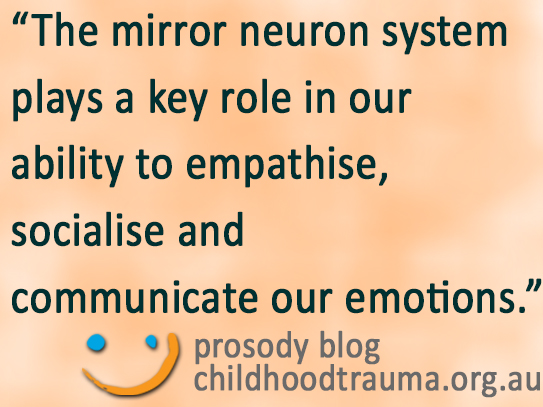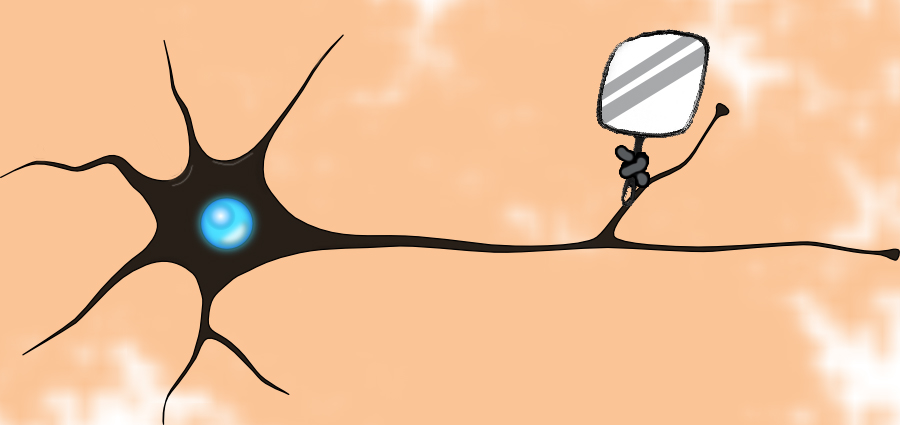
Mirror Neurons & Bucket Fillers

This article was authored by Maria Murray, Senior Training Consultant,
Training and Professional Development Program, Australian Childhood Foundation.
In my time working hands on with children, young people and their families, I was always looking for strategies, activities, books and resources to enhance my therapeutic interventions in ways that were playful non-threatening or re-triggering.
The more I understood the areas of the brain and body impacted by complex trauma, the more able I was to use, adapt or introduce activities, books and resources I already had to repair, rewire and rebuild relational templates.
Whether it is one on one, in therapeutic groups or in specific therapeutic programs for children, young people and their parents, wiring into the prefrontal cortex region of the brain is the foundation for developing empathy, reflection, resilience and relationships. One important way in which we can do these – even with very young children and infants – is through the use of mirror neurons. In this blog, I intent to discuss mirror neurons further, drawing on neurobiology and research. I will also be referencing the work of Carol McCloud in her series of ‘Bucket Filling’ children’s books as a resource for work with children in building their sense of self.
What are Mirror Neurons and why are they important?
Our capacity to instinctively and immediately understand what another is feeling or experiencing is due to our Mirror neurons, sometimes referred to as our empathy or Ghandi neurons.
Mirror neurons in the Prefrontal Cortex not only fire when we perform a certain action but also when we see another make the same movement. They help us decode, receive and interpret, (particularly facial expressions) the intentions and emotions behind the action. For example, smiling for approval or frowning with disgust. The better we are at interpreting facial expressions the more active our mirror neuron system.
Do mirror neurons form the basis of communication and empathy?
 The mirror neuron system plays a key role in our ability to empathise, socialise and communicate our emotions.
The mirror neuron system plays a key role in our ability to empathise, socialise and communicate our emotions.
‘The internal maps created by mirror neurons are automatic – they do not require consciousness or effort. We are hardwired from birth to detect sequences and make maps in our brains of the internal state-the intentional state. A neural circuit called the insula seems to be the information superhighway between the mirror neurons and the limbic (our emotional gateway) areas which in turn send messages to the brainstem and the body proper. This is how we come to resonate physiologically with others – even our respiration, blood pressure and heart rate can rise and fall into sync with another’s internal state – …….resonance circuits is the pathway that connects us to one another.’ Daniel Siegel, Mindsight Change Your Brain and Your Life. 2009
Children and young people who have experienced trauma have very little opportunity to wire into their cortical and prefrontal cortical regions as often they are just trying to survive not ‘because they want to but because they have to’. Energy is spent preventing them from further injury and the necessary messages needed to develop reflection, relationships and resilience, as well as the ability to mention and manage your emotions is stopped by the lower areas of the brain to support survival.
Infants and children possess complex groups of mirror neurons that imitate on an internal level what they see, hear and feel modelled by their caregivers. When these relational templates particularly in early infancy rupture and there is little or no mirroring of repair, children and young people ‘shut down their feelings. They push away memories of pain. They stop relying on relationships around them to protect them. They stop trusting and believing in others.’ (Read more, you can download a free copy of Making Space for Learning)
We can help children and young people heal and mirror messages of repair if we ‘fill their buckets’ regularly. Attunement with primary emotions is the way that children develop the sense of ‘feeling felt’ (Peter Levine, Trauma Through a Child’s Eyes: Awakening the Ordinary Miracle of Healing. 2009) which aids their development. This primary experience is important for children who have experienced trauma as they may not have consistently experienced attuned relationships thus far. In addition they have to be supported to understanding the concept of and desire to fill another’s bucket as this intention may be a new experience and unfamiliar if it has never been mirrored to them – particularly in infancy and early childhood.
In my own work, I have used the idea of filling buckets particularly in therapeutic group work with children middle primary age transitioning to early secondary. These groups were specifically designed to assist children who had been orphaned or abandoned by parental substance misuse and children living with one or both parents that were actively misusing substances. All of the children had experienced complex trauma and were selected because of their challenging and often bullying behaviours. We incorporated the bucket filling concept into our ‘circle time’ and ‘group agreement’ with a commitment to being ‘bucket fillers, not bucket dippers’. Bucket filling helped transform their sense of self as well as a sense of other.
Have you filled a bucket today?
Why not fill one every day– it’s free and brain-food for the prefrontal cortex!
One resource I have found to be useful in work with children is that produced by Carol McCloud. Carol McCloud, was an early childhood educator in the 1990s when she learned of the bucket filling concept while attending an early childhood conference. As she followed the new research on mental, emotional, and social development that was being uncovered in the orphanages of Romania, she began to understand more clearly the intense need that all children share to have their buckets filled by caring adults. Her ‘fill a bucket series’ is a delightful collection of stories aimed at building self-esteem by acknowledging every child and young person’s uniqueness, potential, value and capacity; it is the giving and receiving of positive affirmations, thoughts and feelings using the concept of simply filling an individual’s bucket.
You can find out more about her work, activity ideas and published books on the Bucket Fillers website here.
